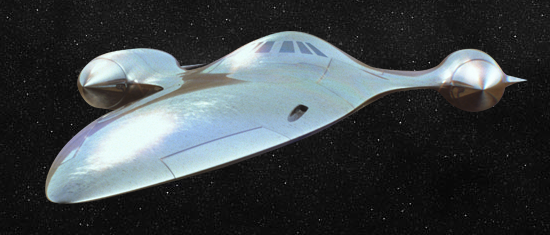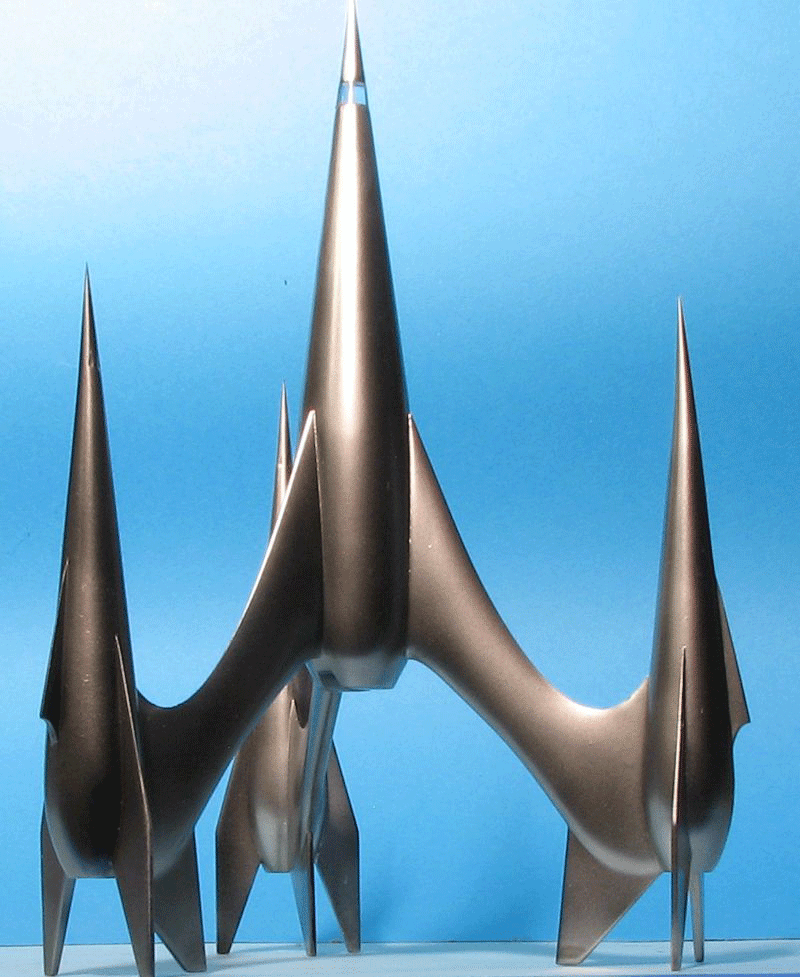For the sake of discussion.
Prior to the 1970s SF tech and hardware on film and television was almost exclusively streamlined. It echoed the clean and uncluttered look of classic era rocketships as well as the view that the future would be simplified and uncluttered. It wasn't an irrational assumption given real world tech and hardware reflected what was assumed in SF in the visual mediums. Real world aircraft and cars and other constructs such as architecture, ships and even household appliances tended to be streamlined and clean in design.
I think that started to change with 2001: A Space Odyssey and the introduction of the Apollo lunar lander. 2001 showed us a mixture of streamlined design as well as seeming to take cues from the Apollo lander by adding more surface detail to the designs. It was a nice balance for the depiction of near future (within a few decades) hardware. And that trend continued into the '70s.
Star Trek might have been one of the last big gasps of streamlined design in SF. Perhaps partially influenced by budgetary concerns and limitations of resources Matt Jefferies was inclined to envision far future tech as being clean and uncluttered suggesting that important hardware could be reached from the inside of the vehicle rather than risk having to go outside the ship. He took the clean look of the classic rocketship and applied it to exotic shapes for the far future. But this look could also be seen in shows like Lost In Space, Voyage To The Bottom Of The Sea and Land Of The Giants.
Things changed in 1977. Star Wars popularized the "industrial" look by taking exotic shapes and applying lots of surface detail. Whereas previously the idea of advanced tech was conveyed through shape and clean design from 1977 onward the idea was conveyed through complexity of detail. And this is the look that has reined since and remains so today. Even Star Trek was influenced by this new aesthetic as greater detailing was added to the exotic Trek shapes beginning with ST-TMP and continued to the present.
The Alien franchise (beginning in 1979) also contributed greatly to the popularity of the industrial look. Star Wars tech tended to look used or second-hand, but Alien's tech looked dirty, worn, neglected and uninviting. Star Trek and Star Wars' tech could give you the urge to climb aboard and take it for a ride, but Alien's tech looked like a dirty factory in space.
There are exceptions to the the rule and even the Alien franchise parted with its factory look (to a point) with the film Prometheus and the introduction of the starship Prometheus which was a lot cleaner and more futuristic looking than previous Alien designs.
Is one aesthetic more valid than the other? I see value in both and I would say they both have a measure of validity--and the dictates of the story or fictional universe should guide the overall look of the tech.
For myself--influenced by growing up in the '60s and '70s--I generally prefer the streamlined look for far future tech and hardware, but I allow that a lot depends on the context. What is balanced could vary from individual to individual, but I appreciate a certain measure of detail to an overall clean design.
Anyone else?
Prior to the 1970s SF tech and hardware on film and television was almost exclusively streamlined. It echoed the clean and uncluttered look of classic era rocketships as well as the view that the future would be simplified and uncluttered. It wasn't an irrational assumption given real world tech and hardware reflected what was assumed in SF in the visual mediums. Real world aircraft and cars and other constructs such as architecture, ships and even household appliances tended to be streamlined and clean in design.
I think that started to change with 2001: A Space Odyssey and the introduction of the Apollo lunar lander. 2001 showed us a mixture of streamlined design as well as seeming to take cues from the Apollo lander by adding more surface detail to the designs. It was a nice balance for the depiction of near future (within a few decades) hardware. And that trend continued into the '70s.
Star Trek might have been one of the last big gasps of streamlined design in SF. Perhaps partially influenced by budgetary concerns and limitations of resources Matt Jefferies was inclined to envision far future tech as being clean and uncluttered suggesting that important hardware could be reached from the inside of the vehicle rather than risk having to go outside the ship. He took the clean look of the classic rocketship and applied it to exotic shapes for the far future. But this look could also be seen in shows like Lost In Space, Voyage To The Bottom Of The Sea and Land Of The Giants.
Things changed in 1977. Star Wars popularized the "industrial" look by taking exotic shapes and applying lots of surface detail. Whereas previously the idea of advanced tech was conveyed through shape and clean design from 1977 onward the idea was conveyed through complexity of detail. And this is the look that has reined since and remains so today. Even Star Trek was influenced by this new aesthetic as greater detailing was added to the exotic Trek shapes beginning with ST-TMP and continued to the present.
The Alien franchise (beginning in 1979) also contributed greatly to the popularity of the industrial look. Star Wars tech tended to look used or second-hand, but Alien's tech looked dirty, worn, neglected and uninviting. Star Trek and Star Wars' tech could give you the urge to climb aboard and take it for a ride, but Alien's tech looked like a dirty factory in space.
There are exceptions to the the rule and even the Alien franchise parted with its factory look (to a point) with the film Prometheus and the introduction of the starship Prometheus which was a lot cleaner and more futuristic looking than previous Alien designs.
Is one aesthetic more valid than the other? I see value in both and I would say they both have a measure of validity--and the dictates of the story or fictional universe should guide the overall look of the tech.
For myself--influenced by growing up in the '60s and '70s--I generally prefer the streamlined look for far future tech and hardware, but I allow that a lot depends on the context. What is balanced could vary from individual to individual, but I appreciate a certain measure of detail to an overall clean design.
Anyone else?



